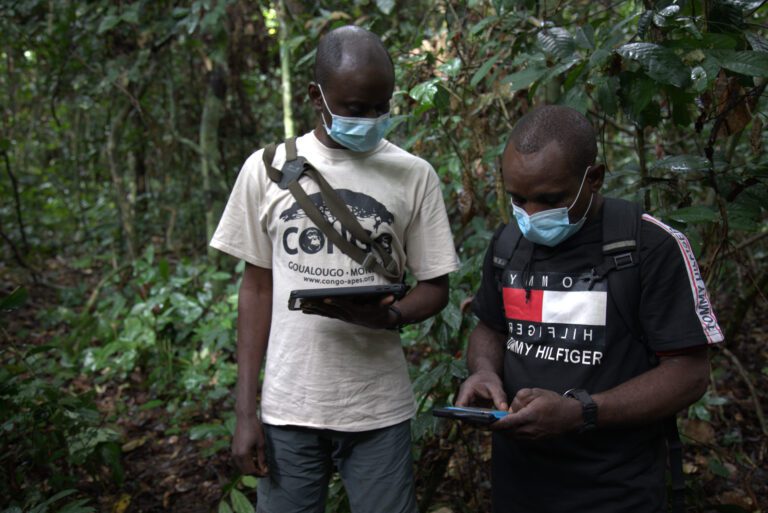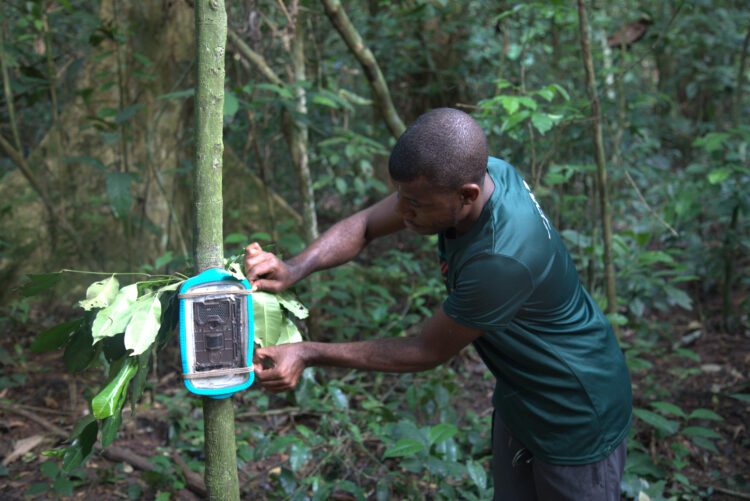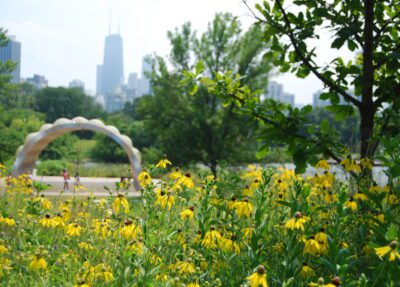Diving Deeper: Goualougo Triangle Ape Project, Part II
For more than two decades, the Goualougo Triangle Ape Project (GTAP) has been a fixture in the Republic of Congo, immersing researchers in a pristine jungle environment where great ape research isn’t just a job—it’s a way of life, an interconnected web of community, science, and conservation. And because nothing stays static, especially life, the scientists have seen quite a bit of change to their environment over the years.
The History of GTAP Research
In 1993, under the direction of Michael Fay, a researcher with the Wildlife Conservation Society, Nouabalé-Ndoki National Park was established. The region set aside for protection did not include the cone-shaped Goualougo Triangle, which was part of a logging concession. That status meant that it would likely eventually be logged—except that fortunately, the logging company with the rights (Congolaise Industrielle des Bois, or CIB) was seeking forest certification for the concession and had the foresight to understand the benefits of sustainable harvesting. CIB eventually eventually relinquished its rights. This move allowed Goualougo to become protected land.
David Morgan, Ph.D., GTAP’s principal investigator, had come to the area as a volunteer and then proposed a study on the naïve chimpanzees in the Goualougo, which was initiated in 1999. His future partner both in science and in domestic matters, Crickette Sanz, Ph.D., was a Washington University (St. Louis, Missouri) graduate student who came out to Goualougo after writing him a letter. From an initial staff of just three, the simple camp the two started at has become a research station, providing support, employment, education, and more to the communities nearby.
The isolated and intact nature of Goualougo makes this a wonderful laboratory for researchers in fields like forest ecology, botany, and the study of large mammals. From the beginning, researchers have investigated important issues here, such as the impact of logging, the status of food sources in pristine areas, the complicated dynamics of gorilla and chimpanzee families, and the intersection of human and primate health as a way of battling emerging diseases. In fact, GTAP was among the first projects of its kind to recognize the importance of focusing on ape health.
Over the years, the researchers here have discovered sub-species, helped create policy, and quantified diversity in this unparalleled environment. And they’ve done so with a certain amount of ingenuity—there’s still a lot of what Morgan describes as a “cobble things together to get what we need” style of activity going on. But the work remains constant and important.
The Importance of Long-term Research
The changes Morgan, Sanz, and others at GTAP have seen don’t just mean alterations to their physical camp or an increase in people, though. The attitudes of people in the area have also changed. From thinking of GTAP as a strange or intrusive endeavor that wouldn’t last, residents of local villages now consider it an indelible part of the landscape, offering economic opportunity and education. GTAP has been also been part of bringing tourism and infrastructure development into the area, including efforts by the Wildlife Conservation Society to build housing and a new school in the town of Bomassa.
Some of this change affects the animals, too. Many had not really had experiences with humans before GTAP started. That means that researchers were able to study their first contacts with people, and could also report on how the process of habituating apes to their presence went.

Long-term research sites provide invaluable knowledge about many species over time, in a landscape that continues to be altered by human hands. GTAP staff members have been able to study not just animal families, but generations of them. And it has been able to help Congolese families that make up a huge part of the GTAP staff build generational wealth while sharing and benefiting from knowledge passed down orally.
Researchers can learn about new plants and animals, figure out how generational social and reproductive dynamics play out over time, gain insights on human evolution, and address questions related to resource use, competition, and tool use. Along with that, they advocate for animals and continue dialogues with partners, governments, NGOs, and policy-driven organizations while building community within the region.
“You can do science that informs conservation issues and keep the pressure on,” Morgan says.
Research on Foot
Habituating the apes to the presence of humans was one of the initial tasks that needed to be done when GTAP began in 1999. Once that was accomplished, teams could follow these apes and collect behavioral, health, and ecological data on smartphones and iPads. The area has been separated into zones, and baseline information was gathered first to make sure we could track what changed over the years.
The GTAP crew consists of conservation-focused scientists, forest guides, and collaborators who work together to do field research over the two remote sites, including around 45 trackers. In fact, each gorilla group ideally gets a team of two researchers and five expert trackers, who know the forest and the individual animals and their families so well that their abilities to locate them using all their senses have been called “otherworldly.”
Daily reconnaissance walks and transect surveys also take place. Researchers collect fecal and urine samples, track the apes, and count their nests—a process that allows scientists to accurately record their populations.

“Trackers work on specific transects, or they follow specific ape groups and elephant groups,” Morgan says. “There are teams that just do transects. It’s a different type of work; they have food and equipment on their backs and travel in teams of nine or more. You give them a GPS point and they walk a straight line to that point. Along the way, they look for chimp nests, gorilla nests or the animals themselves, and that’s how we count how many apes are in the forest. That’s how we get the estimate that there are 1.2 chimps per square kilometer. They go out and hike for 30 days, 45 kilometers (about 28 miles) at a time.”
As a result of this type of work, even shoewear in Goualougo has changed. Back in the day, GTAP staff wore name-brand sandals and duct-taped their feet to protect them. Fortunately, the shoewear situation at the camp has become a bit more practical over the years, and sandals are no longer in vogue there.
Using Technology
The team here uses standardized field monitoring protocols to learn more about the apes, but also incorporates rigorous study design and a suite of research methods to gain information about the threats to apes, like poaching and timber exploitation. Repeated surveys evaluate populations and how they’ve been affected by human disturbances to their habitat.
Along with direct observations gained by following the animals, GTAP scientists began pioneering remote camera trapping in 2003. This allows some of the research to be done passively, through monitors.
Now, there are 65 remote video units covering a 60-square-mile area, about half of which capture the action in four chimp communities. These “Chimpcams,” housed in chimpanzee-proof casings, have documented the visits of chimpanzees to termite nests in a longitudinal investigation of their tool-using repertoires and cognition. Generations of ape families have and will continue to be documented.
“No one had ever studied chimps in Central Africa like we do. We pioneered putting cameras out to study chimp behavior, which helps us learn about chimpanzee similarities and differences by range. Other organizations, including the Max Planck Institute, have also started putting cameras in different places to find out what chimps are doing in other areas.”
– David Morgan, Ph.D.
The cameras were also expanded to find out more about the wider biodiversity in the neighboring Djeke Triangle—so it isn’t just the apes that benefit from the presence of the technology and research. The cameras documented so many of the animals in this area, from DeBrazza’s monkeys to snakes, that this evidence of the region’s unique environment status supported calls to the government officials to elevate the Djeké Triangle’s protected status. This directly led to government officials in the Republic of Congo and logging company CIB to support the Djeké Triangle’s inclusion into Nouabale-Ndoki National Park in early 2023.
In addition to studying the animals, GTAP has botanists on staff who have established botanical plots that help it determine how development, including logging, impacts the forests over time. This not only provides information about ape survival prospects, but also the potential of the forest in reducing carbon emissions into the atmosphere.
Goualougo researchers started out with hand-written notes and drawings. Today, though, they capture data using programs like FieldTracker, which they developed to fill a need for an app that doesn’t use Wi-Fi. All the data is sent to Lincoln Park Zoo’s Lester E. Fisher Center for the Study and Conservation of Apes. The Goualougo Video Analysis Lab here reviews all the data—currently, about seven terabyes worth of information—and collates, records, and analyzes it.

What We’ve Learned
There’s so much to learn in Goualougo. This is a region so rich with life it’s considered the second densest tropical rainforest after the Amazon, and institutions such as the Royal Botanic Garden in Edinburgh, Scotland as well as Wageningen University, Netherlands, have become involved to investigate the species of flora being found here.
Until the last couple of decades or so, most of the research done on gorillas came from population surveys and indirect signs—like nests. But, because Goualougo staff were able to habituate great apes to human presence, they’ve been able to learn so much. The habituation in itself was a major learning process, of course, adding to the body of knowledge about gorilla behavior. And as the gorillas became more comfortable with humans, reverting to their normal routines, it has given researchers unparalleled access to the activities of these great apes.
Some of the information, like population differences at various times and locations, can be correlated with logging practices in the region to determine how successful sustainable logging efforts in the area are. One study, headed by David Morgan and published in 2018, notes that chimp nests are found a lot less often in areas with more human impact, while gorillas are attracted to recently logged areas as long as they have a lot of herbaceous vegetation. In general, both species were adversely affected by logging, but they had flexible coping strategies that allowed them to stick to their ecological preferences even when their habitats were altered.
Other research, like the work Sanz specializes in regarding how chimps use tools (more than 22 different kinds, to date), bring us closer to understanding their minds and the way they pass on information to others in their social groups.
In fact, while Dr. Jane Goodall might have been the first scientist to see tool use in chimps, the researchers at Goualougo were the first to discover that chimps could use multiple tools to accomplish two different tasks in pursuit of one goal.
“The complex tool use—not just one type of behavior but multiple behaviors—certainly put Goualougo on the map while showcasing how special chimps are,” Morgan says.
Overall, more than 70 peer-reviewed studies and plenty of other media, including writings by National Geographic and others, have come out of Goualougo. This included GTAP producing a set of ape-friendly logging guidelines outlining best practices for forestry companies, which was published by the International Union for the Conservation of Nature in 2013.

Tools used by chimpanzees in the Congo
Where Are We Going?
So much information has come out of Goualougo, and they’re not even close to done. As the researchers move forward, though, they plan to continue monitoring how forests are changing outside the national park and how that’s impacting the apes. They will also continue to address the human factor, finding out more about diseases and how their presence might affect primate survival in the forests.
Along with that, GTAP plans to encourage more community involvement, creating additional paths to help local people protect the forests. And, its research will incorporate more comparisons with the apes at Lincoln Park Zoo.
“We are going to start looking at activity budgets, social networks, personalities—we can learn a lot when we look between wild and captive populations. We’re just getting there, though, to be able to do comparisons with tool use. That’s an important aspect,” Morgan says.






